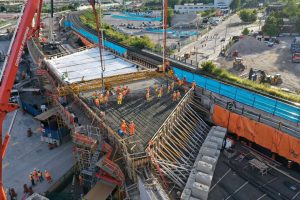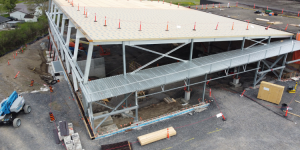Almost 70 years after it was first conceived, the Trans-Canada Highway remains a historically significant engineering and construction achievement. At 8,030 kilometres in length, it’s one of the five longest highways on earth, stretching from Victoria, B.C. to St. John’s, N.L.
In typical Canadian fashion, the country seems to have downplayed the achievement. With construction beginning in 1950, the road was officially completed in 1971, and was marked by a modest final report issued by the Minister of Public Works. As David W. Monaghan notes in his 2002 book "Canada’s ‘New Main Street’: The Trans-Canada Highway as Idea and Reality" a reluctance to celebrate the construction of the road at a national level may simply reflect the recognition that, under Confederation, roads are a provincial responsibility. On project completion, everyone returned to their familiar roles and took responsibility for their own section of the road.
Although the highway was completed long before he earned his degree, Donaldson MacLeod, P. Eng. has driven its entire length and has worked on highway maintenance and improvement projects where the roadway passes through Canada’s national parks from 1984 to 2010. In 2014, he prepared a historical report on the highway’s history for the Transportation Association of Canada.
He notes that the Canadian Highway Association pushed for the idea of a national highway as early as 1912, but that the project didn’t gain real traction until the years following the Second World War.
"It was a combination of the post-war economic boom and a rapid increase in car ownership that helped to popularize the idea," he says. Cross-country commerce was also on the minds of the Canadian business community, which relied on rail and shorter-run trucking to deliver goods.
The federal government passed "An Act to Encourage and to Assist in the Construction of a Trans-Canada Highway" or the "Trans-Canada Highway Act" on Dec. 10, 1949, just a few months after Newfoundland entered Confederation. Under the act, the federal government would work with the provinces on a cost-sharing agreement to build the highway system.
The federal government offered $150 million to a maximum of 50 per cent of the shared costs. Because the national park system was federally maintained, the government of Canada would take on 100 per cent of the cost of building roads through the parks. Each section of the highway was covered under a separate agreement, with British Columbia, Alberta, Saskatchewan, Manitoba, Ontario and Prince Edward Island signing up first on April 25, 1950, and Quebec the last, agreeing on Oct. 27, 1960.
Donaldson MacLeod
Professional Engineer
"It was significant that the federal government agreed to take on the cost burden of the sections running through the national parks," says MacLeod. "Those sections were considered the most difficult of all the projects."
Construction began under the auspices of the Department of Resources and Development but was picked up by the Department of Public Works (DPW) in September 1953.
"There was a bit of friction in that all of the design, tender calls, contract awards and construction for the provincial sections of roadway were the responsibility of the provinces, but they were all subject to review by federal authorities and federal inspectors," says MacLeod. "There was a lot of back-and-forth on lane widths, guardrail location, grades, pavement thickness and funding. The inspectors weren’t so much inspecting the quality of the work as inspecting the provinces to make sure that the money contributed by the federal government was being used in the right places."
Considering the difficulties of construction and varying conditions in each province, the federal government ultimately agreed to pick up 90 per cent of the construction tab.
The road covered a wide variety of terrain from province to province, with each section presenting unique construction challenges. Some of the highway followed the paths of existing roadways while other sections involved forging through virgin territory.
The three major physical challenges to construction were identified as "muskeg, gumbo and rock."
The 256-kilometre section of highway along Lake Superior between Wawa and Sault Ste. Marie was among the most challenging, with 60 per cent of the project forging through new ground. Muskeg was the greatest obstacle, with sections ranging to 15 metres deep and requiring 25 new bridges to be built.
 Heavy equipment working on the construction of the Trans-Canada highway in Alberta circa 1954. Construction of the highway covered a wide variety of terrain from province to province, with each section presenting unique construction challenges. – Photo:ROSEMARY GILLIAT EATON/LIBRARY AND ARCHIVES CANADA
Heavy equipment working on the construction of the Trans-Canada highway in Alberta circa 1954. Construction of the highway covered a wide variety of terrain from province to province, with each section presenting unique construction challenges. – Photo:ROSEMARY GILLIAT EATON/LIBRARY AND ARCHIVES CANADA"They had to bring in thousands of tonnes of blast rock to create a solid road base," says MacLeod. "The depth of the muskeg is misleading. If you have muskeg 10 feet deep, and fill it with rock, it depresses the bottom of the formation and you have to find another seven feet worth of rock to crest the surface."
In Saskatchewan, gumbo clay can turn quickly to slippery mud when soaked. Tonnes of gravel underlayment were required to provide a stable road base. Despite that challenge, Saskatchewan was the first province to finish its 654-kilometre section of the highway in 1957.
British Columbia provided the greatest challenges in terms of blasting and moving rock, particularly through the Fraser and Kicking Horse Canyons. Completion of the 15-kilometre section between the communities of Golden and Field saw the removal of more than two million tonnes of rock and another two million tonnes of soil.
Two distinct projects represented the greatest construction challenges.
The first was the 45-kilometre section through Glacier National Park in B.C. The chosen path through Rogers Pass was the same one originally selected by the Canadian Pacific Railway, which built a rail line there in 1882. However, heavy snows and avalanches convinced the railway to abandon the route in 1916 and divert the track through a tunnel.
"The Trans-Canada Highway was supposed to be an all-season highway," says MacLeod. "They couldn’t accept the idea of a highway that might be closed as many as 75 days a year during winter."
The Avalanche Research Group was formed in 1953 by DPW to identify potential avalanche zones, and devise methods to protect motorists. The group identified 825 metres of the route that could be protected by concrete "avalanche sheds" built across the road. It also identified emplacements for military personnel armed with Howitzers to fire shells into avalanche trigger zones to prevent larger avalanches from occurring.
"There was a tremendous amount of earthwork done, which included the formation of earth diversion dams to divert avalanches from the highway, and excavations into the mountainside to retain snow slides," says MacLeod.
Weather didn’t help construction. In a typical year, the area received 8.5 metres of snow. During the winter of 1953 it received almost 17.
The other challenging project was the construction of the Louis-Hippolyte Lafontaine Bridge–Tunnel, which runs over and under the St. Lawrence River, connecting the Island of Montreal with the south shore of the river at Longueuil, Que. The 1,391-metre tunnel section of the project was completed in 1967 and remains one of the largest pre-stressed concrete structures in the world.
Seven pre-stressed sections of the tunnel were formed in dry dock at a casting basin on Ile Charron near the site. Each section weighed 32,000 tonnes and measured 110 metres long, 37 metres wide and eight metres high.
"A trench had been pre-excavated in the river bed," says MacLeod. "Each section was floated into place by barge. Then construction assembly teams would build the concrete roadway deck and steel reinforcement bars inside each section, being careful not to capsize that segment. When finished, the barge would float out to the right location and sink that section of the tunnel until it touched bottom, 24 metres below the surface of the water. This was long before the days of GPS, so positioning of each section was critical to the successful completion of the project."
One of the reasons that the engineering achievement of the Trans-Canada Highway may have slipped beneath the radars of the general public was its extended construction schedule. Like the "last spike" driven into the CPR trans-continental railway, the opening day ceremonies represented significant milestones in construction, but not completion.
The federal government celebrated the opening of the highway at Rogers Pass on Sept. 3, 1962.
One of the first people on the new road was A.D. Booth, a truck driver from Salmon Arm B.C., who transported 264 crates of fresh strawberries to Calgary. The day trip-would have required three days by rail.
But significant work remained to be done. By 1967, for example, most of the gravel sections of the highway had been paved. Upon completion of the original project parameters in 1971, the cost of the project stood at $1.4 billion—about $8.9 billion in 2017 currency.
The evolution of the Trans-Canada highway continues as routes are twinned, roads are improved and the highway network is gradually extended.
"But the original construction remains a major accomplishment and a pretty impressive feat of engineering," says MacLeod.
"That achievement often gets lost in the work of modern construction. What’s amazing to me is that, despite city by-passes and extensions, the highway remains pretty much along the same route as it was originally laid out. The engineers and construction teams built something of lasting value."










Recent Comments
comments for this post are closed